Entry Database : PDB / ID : 2zejTitle Structure of the ROC domain from the Parkinson's disease-associated leucine-rich repeat kinase 2 reveals a dimeric GTPase Leucine-rich repeat kinase 2 Keywords / / / / / / / / / / / / / / / Function / homology Function Domain/homology Component
/ / / / / / / / / / / / / / / / / / / / / / / / / / / / / / / / / / / / / / / / / / / / / / / / / / / / / / / / / / / / / / / / / / / / / / / / / / / / / / / / / / / / / / / / / / / / / / / / / / / / / / / / / / / / / / / / / / / / / / / / / / / / / / / / / / / / / / / / / / / / / / / / / / / / / / / / / / / / / / / / / / / / Biological species Homo sapiens (human)Method / / / Resolution : 2 Å Authors Deng, J. Journal : Proc.Natl.Acad.Sci.Usa / Year : 2008Title : Structure of the ROC domain from the Parkinson's disease-associated leucine-rich repeat kinase 2 reveals a dimeric GTPaseAuthors : Deng, J. / Lewis, P.A. / Greggio, E. / Sluch, E. / Beilina, A. / Cookson, M.R. History Deposition Dec 13, 2007 Deposition site / Processing site Revision 1.0 Jan 22, 2008 Provider / Type Revision 1.1 Jul 13, 2011 Group / Version format complianceRevision 1.2 Oct 11, 2017 Group / Refinement description / Category / softwareRevision 1.3 Nov 6, 2024 Group Advisory / Data collection ... Advisory / Data collection / Database references / Derived calculations / Structure summary Category chem_comp_atom / chem_comp_bond ... chem_comp_atom / chem_comp_bond / database_2 / pdbx_entry_details / pdbx_modification_feature / pdbx_struct_conn_angle / pdbx_unobs_or_zero_occ_atoms / struct_conn / struct_conn_type / struct_site Item _database_2.pdbx_DOI / _database_2.pdbx_database_accession ... _database_2.pdbx_DOI / _database_2.pdbx_database_accession / _pdbx_struct_conn_angle.ptnr1_auth_comp_id / _pdbx_struct_conn_angle.ptnr1_auth_seq_id / _pdbx_struct_conn_angle.ptnr1_label_asym_id / _pdbx_struct_conn_angle.ptnr1_label_atom_id / _pdbx_struct_conn_angle.ptnr1_label_comp_id / _pdbx_struct_conn_angle.ptnr1_label_seq_id / _pdbx_struct_conn_angle.ptnr3_auth_comp_id / _pdbx_struct_conn_angle.ptnr3_auth_seq_id / _pdbx_struct_conn_angle.ptnr3_label_asym_id / _pdbx_struct_conn_angle.ptnr3_label_atom_id / _pdbx_struct_conn_angle.ptnr3_label_comp_id / _pdbx_struct_conn_angle.ptnr3_label_seq_id / _pdbx_struct_conn_angle.value / _struct_conn.conn_type_id / _struct_conn.id / _struct_conn.pdbx_dist_value / _struct_conn.pdbx_leaving_atom_flag / _struct_conn.ptnr1_auth_asym_id / _struct_conn.ptnr1_auth_comp_id / _struct_conn.ptnr1_auth_seq_id / _struct_conn.ptnr1_label_asym_id / _struct_conn.ptnr1_label_atom_id / _struct_conn.ptnr1_label_comp_id / _struct_conn.ptnr1_label_seq_id / _struct_conn.ptnr2_auth_asym_id / _struct_conn.ptnr2_auth_comp_id / _struct_conn.ptnr2_auth_seq_id / _struct_conn.ptnr2_label_asym_id / _struct_conn.ptnr2_label_atom_id / _struct_conn.ptnr2_label_comp_id / _struct_conn.ptnr2_label_seq_id / _struct_conn_type.id / _struct_site.pdbx_auth_asym_id / _struct_site.pdbx_auth_comp_id / _struct_site.pdbx_auth_seq_id
Show all Show less
 Yorodumi
Yorodumi Open data
Open data Basic information
Basic information Components
Components Keywords
Keywords Function and homology information
Function and homology information Homo sapiens (human)
Homo sapiens (human) X-RAY DIFFRACTION /
X-RAY DIFFRACTION /  SYNCHROTRON /
SYNCHROTRON /  SAD / Resolution: 2 Å
SAD / Resolution: 2 Å  Authors
Authors Citation
Citation Journal: Proc.Natl.Acad.Sci.Usa / Year: 2008
Journal: Proc.Natl.Acad.Sci.Usa / Year: 2008 Structure visualization
Structure visualization Molmil
Molmil Jmol/JSmol
Jmol/JSmol Downloads & links
Downloads & links Download
Download 2zej.cif.gz
2zej.cif.gz PDBx/mmCIF format
PDBx/mmCIF format pdb2zej.ent.gz
pdb2zej.ent.gz PDB format
PDB format 2zej.json.gz
2zej.json.gz PDBx/mmJSON format
PDBx/mmJSON format Other downloads
Other downloads 2zej_validation.pdf.gz
2zej_validation.pdf.gz wwPDB validaton report
wwPDB validaton report 2zej_full_validation.pdf.gz
2zej_full_validation.pdf.gz 2zej_validation.xml.gz
2zej_validation.xml.gz 2zej_validation.cif.gz
2zej_validation.cif.gz https://data.pdbj.org/pub/pdb/validation_reports/ze/2zej
https://data.pdbj.org/pub/pdb/validation_reports/ze/2zej ftp://data.pdbj.org/pub/pdb/validation_reports/ze/2zej
ftp://data.pdbj.org/pub/pdb/validation_reports/ze/2zej Links
Links Assembly
Assembly
 Components
Components Homo sapiens (human) / Gene: LRRK2 / Plasmid: pSKB3 / Production host:
Homo sapiens (human) / Gene: LRRK2 / Plasmid: pSKB3 / Production host: 
 X-RAY DIFFRACTION / Number of used crystals: 1
X-RAY DIFFRACTION / Number of used crystals: 1  Sample preparation
Sample preparation SYNCHROTRON / Site:
SYNCHROTRON / Site:  APS
APS  / Beamline: 19-ID / Wavelength: 0.97948 Å
/ Beamline: 19-ID / Wavelength: 0.97948 Å Processing
Processing SAD / Resolution: 2→38.8 Å / Cor.coef. Fo:Fc: 0.951 / Cor.coef. Fo:Fc free: 0.924 / SU B: 8.66 / SU ML: 0.14 / TLS residual ADP flag: LIKELY RESIDUAL / Cross valid method: THROUGHOUT / ESU R: 0.198 / ESU R Free: 0.182 / Stereochemistry target values: MAXIMUM LIKELIHOOD / Details: HYDROGENS HAVE BEEN ADDED IN THE RIDING POSITIONS
SAD / Resolution: 2→38.8 Å / Cor.coef. Fo:Fc: 0.951 / Cor.coef. Fo:Fc free: 0.924 / SU B: 8.66 / SU ML: 0.14 / TLS residual ADP flag: LIKELY RESIDUAL / Cross valid method: THROUGHOUT / ESU R: 0.198 / ESU R Free: 0.182 / Stereochemistry target values: MAXIMUM LIKELIHOOD / Details: HYDROGENS HAVE BEEN ADDED IN THE RIDING POSITIONS Movie
Movie Controller
Controller


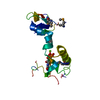


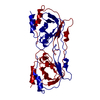
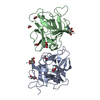
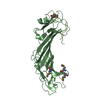
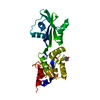
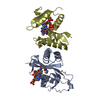
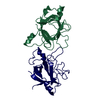
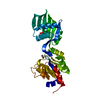
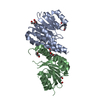
 PDBj
PDBj












